-
Engine1.4L I4
-
Power197 HP / 113 LB-FT
-
Transmission6-Speed Sequential
-
0-60 Time3.92 Seconds
-
Top Speed144 MPH
-
DrivetrainRear-Wheel Drive
-
Curb Weight1,040 LBS (dry)
-
Seating2
-
MPG30 MPG
As much (or as little) as our conscience might drive us to applaud initiatives to reduce fuel consumption and carbon emissions – and thereby, our compatriots at AutoblogGreen tell us, prevent us all from going the way of the dinosaur – deep down, the real car nuts inside and among us love cars that tend to consume the most fossils. Naming a car after a dinosaur, however, is another matter.
When Ford's Special Vehicle Team wanted to distinguish its rip-roaring off-road pickup from the workaday F-150, they called it the Raptor. When Saleen designed a conceptual successor to the S7 supercar, it also chose the name Raptor. But back in the day when both those teams of Ford performance specialists were still hot-rodding the Fox-body Mustang, a small outfit in the Canadian province of Quebec was already building its own dino-named tribute, a three-wheeler called the T-Rex.
Having driven its newer, more Harley-like stablemate the V13R last summer, we returned to Montreal to take the T-Rex out for the day to answer the lingering question on our minds: Namely, is the T-Rex named after a dinosaur because it's been on the market for decades and should, by all accounts, be long since extinct? Or is it so named because it's an irreverent monster that will bite your head off and consume everything in its path?
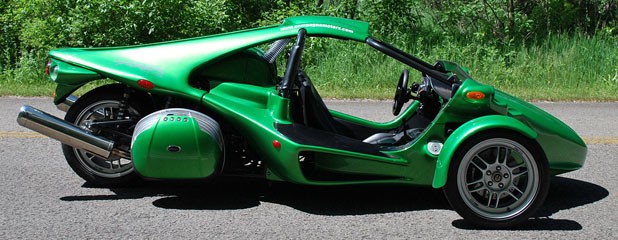
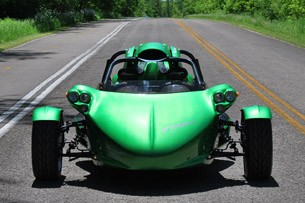
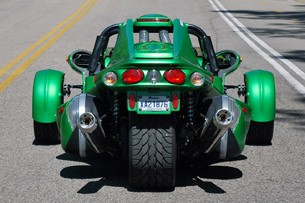
Campagna Motors has been making the T-Rex since the early 1990s, but while some components have changed, the design and basic formula haven't. The company effectively merged with a similar upstart called Cirbin that developed the V13R a few years ago, and today it builds both on the same production line in Boucherville, Quebec, just across the river from Montreal.
Like the V13R, the T-Rex's footprint places two wheels up front and a third driven wheel in the back. Both trikes' cockpits are open for the most part, with tandem bucket seats and controls (including steering wheel, shifter and pedals) closer to what you'd find in a car than what you'd expect of the motorcycles that donated their engines.The T-Rex takes more of a sport-bike approach than the Harley-powered V13R.
The T-Rex, however, takes more of a sport-bike approach than the Harley-powered V13R. It's based on the mechanicals of a Kawasaki Ninja, and not just any Ninja: the top-of-the-line ZX-14, known overseas as the ZZR1400. That means 1.4 liters of capacity across four cylinders – small by car standards, but gargantuan for a motorbike engine – putting down 197 horsepower and 113 lb-ft of torque down to that 295-section rear tire via chain drive and a six-speed sequential gearbox sourced from Kawasaki but adapted to purpose (complete with reverse mechanism) by Campagna. Unfortunately, while HDMC will sell Campagna just the engine and other components its needs to build the V13R, the company is forced to buy the entire bike from Kawasaki, remove the parts it needs to make the T-Rex and sell off the rest.
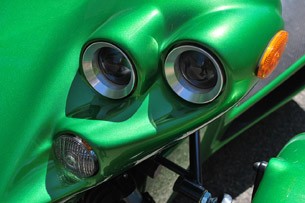
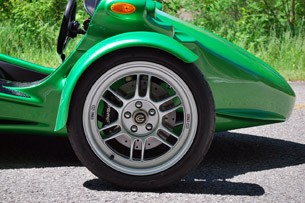
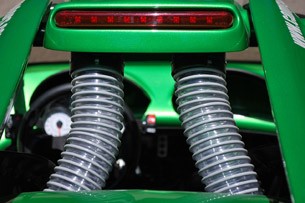
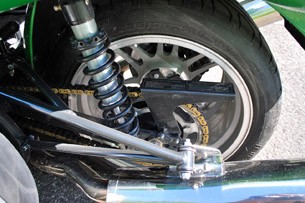
The result, however, is unlike almost anything else on the road. Almost. Compared to the V13R, it's considerably more powerful, but at a whopping $58,349 to start, it's also a good ten grand more expensive. (It's also nearly six grand more than an Ariel Atom, a heavier but more powerful vehicle that's a full tick of the clock quicker to 60 mph.) The T-Rex sits just as low to the ground, but where the entirely roofless V13R packs its structural reinforcement where you'd expect to find the doors, the T-Rex, which has since adopted the 14R moniker, is braced by a narrow roof beam (dominated by the central air intake) and pillars that would frame a windshield and side glass if there were any to speak of beyond a little deflector.It's nearly six grand more than an Ariel Atom, a heavier but more powerful vehicle that's a tick of the clock quicker to 60 mph.
Access is thereby granted via larger "door" apertures, but slithering in is just as tricky. Remove the steering wheel, we were advised, then sit on the back of the sill, slide your feet in and lower yourself into the low-slung seat. You end up feeling like Valentino Balboni backing up a Lamborghini.
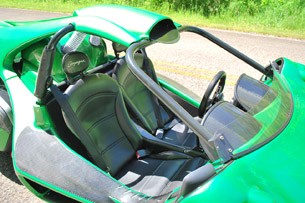
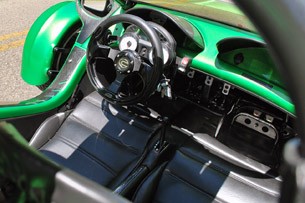
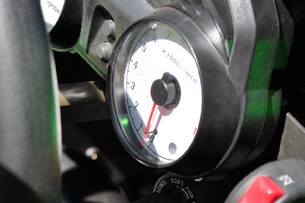
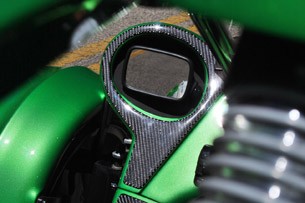
Once we were inside with our seatbelt fastened, helmet secured (in accordance with local regulations and good sense), steering wheel affixed and ready to get underway, we were advised to avoid the temptation (as too many apparently had not) to reach out and touch the rapidly passing tarmac below. It's familiar advice to anyone who grew up in a cold climate (like Montreal) and was warned not to lick anything metallic, and it only goes to show just how low you sit in the cockpit and how exposed you are to the elements. Conversely, watching the suspension actuating and hearing the brake calipers grip the ventilated discs is a treat for a mechanical enthusiast.Watching the suspension actuating and hearing the brake calipers grip is a treat for a mechanical enthusiast.
Those curiosities were soon eclipsed, however, by the unbridled rawness of the full T-Rex experience. The engine normally (if you can call a motorbike with as much power as a Scion FR-S "normal") found between a rider's knees is placed in the T-Rex right behind the occupants' heads. The upshot is a cataclysmic wail that we'd sooner let you hear for yourself in the video below than venture to describe.

The engine screaming over your shoulder, however, is just part (a big part, mind you) of the rawness that is the real draw of the T-Rex. With just a pair of removable 46-liter hard cases mounted vertically (instead of horizontally as they would be on a motorcycle, making them a little trickier to close securely), the T-Rex offers little more practicality than a bike, but it needs to be parked like a car. It also leaves its occupants almost completely exposed to the elements, so having envisioned in our minds driving a car, we were left with a nice trucker's sunburn on our left arm. (On the other hand, the day on which we were originally supposed to drive the T-Rex, Montreal was engulfed by a deluge of nearly biblical proportions, so we were glad to have rescheduled to follow the sun.) The flipside of that rawness, however, is a wind-in-your-face experience that is more visceral – and more entertaining – than just about anything else on the road.Campagna claims its Jurassic-era beast will hit 60 mph in under four seconds and go on to a top speed of 144 mph.
The relative speed sensation you get in the T-Rex, then, is what makes it as much fun as it is – even driving in a straight line at highway speeds. But don't get us wrong: It's not just about perception. The T-Rex has the numbers to justify the hairs standing up on the back of your neck. With just 1,040 pounds to motivate, Campagna claims its Jurassic-era beast will hit 60 mph in under four seconds and go on to a top speed of 144 mph. All the while it will hold on for 1.3 Gs of lateral acceleration on a skidpad – numbers which we didn't come to doubt while driving on the twisty country roads from Boucherville (south east of Montreal) all the way to Oka National Park out west on the river's North Shore.
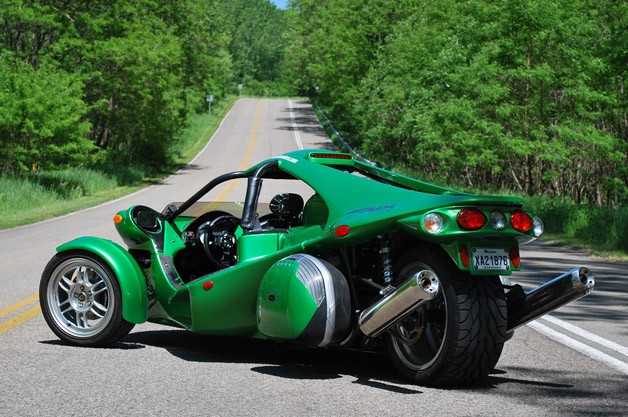
Reminded of how easily the rear tire broke traction on the more sedate V13R, we heeded the warnings not to mash the throttle on the more vicious T-Rex, lest we end up pointing the wrong way on short notice. We also didn't have as much trouble getting used to the biting point on the T-Rex's clutch, but that could come down in part to having grown familiar with the mechanism on the V13R during our previous drive.
Bringing back the T-Rex to Boucherville after a full day of enjoying all it had to offer, we gave back the keys – rather reluctantly, we might add – and climbed back into the Acura TL we had driven out there in the morning. The luxury sedan, by comparison, felt like an SUV wafting down the road. The more familiar sensation, however, came when we went to see the latest Cirque du Soleil show at the Old Port that evening, watching the contortionists, jugglers and acrobats doing what they do and remembering the serpentine ordeal we gladly undertook to get in and out of the Campagna's tight cockpit.The T-Rex might be as old as the predator for which it was named, but it's every bit as raw, wild and vicious.
At the end of the day, the question we embarked upon answering when we picked up the keys that morning was addressed by our gut reaction: the T-Rex might be as old as the predator for which it was named, but it's every bit as raw, wild and vicious. And in an industry where beasts are routinely tamed by electronics nannies mandated by government regulators and the creature comforts demanded by customers, the T-Rex is a rare beast indeed.
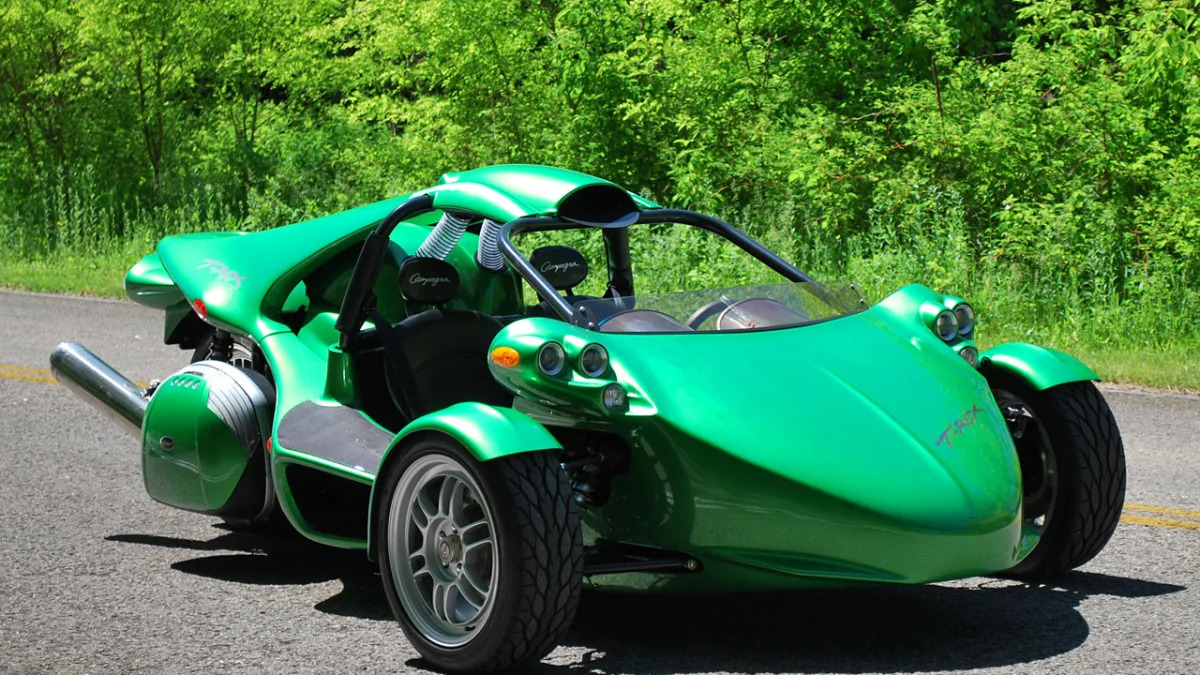









Sign in to post
Please sign in to leave a comment.
Continue